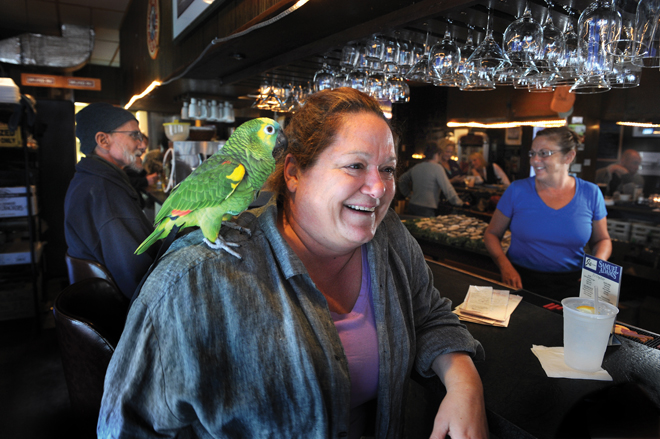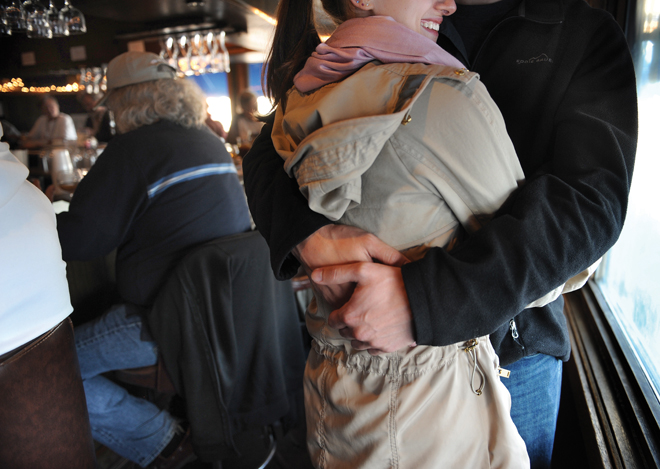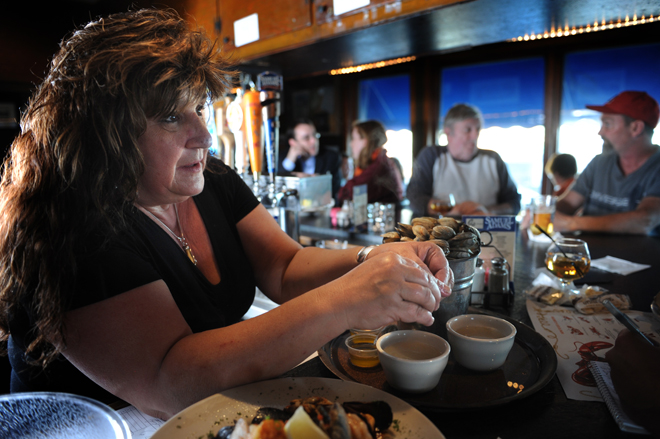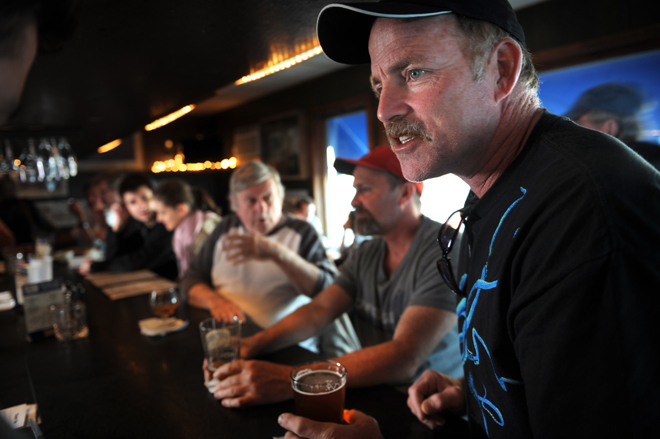J’s Oyster Bar
Cindy Brown is sitting on a stool at J’s Oyster Bar on a cloudy Thursday afternoon in May. On her right shoulder, attached to her belt by a black leash, is a green parrot called Mayzie—named after the “lazy bird” Mayzie McGraw, from a Dr. Seuss book. On the stool to Cindy’s left sits her husband, Lester Brown, who, somewhat concealed by a scarf and a knit hat, is drinking a mug of something warm while enduring the late stages of cancer.
Cindy is the co-owner of J’s Oyster Bar. The other co-owner is her older sister, Colleen Williams. They are two of the four daughters of the late Janice Noyes, a legendary woman who opened J’s in 1977 during a period when downtown Commercial Street was not restaurant- and boutique-laden but a working waterfront haunted by thirsty fishermen with money to burn. Janice is the J for whom the bar is named, and regulars still talk about her as if she were alive. On the back page of the J’s menu, there is a letter from Janice to her customers explaining why she opened the place: there were no raw oysters in Portland. She felt that there should be. The letter was written 35 years ago. It says so on the menu.
The J’s building is a sturdy, white, inglorious square-shaped thing, about the size of a one-car garage, built upon a foundation of invisible wooden pilings that are beaten daily by the salty tides of Casco Bay. You cannot really see J’s unless you know where it is. One way to find it is by following the rich and salty smell of grease and the ocean down a small pot-holed and seedy-looking alley that leads to a wharf. Another way to find the bar is by passing through the tall gates of DiMillo’s—a seafood restaurant that occupies a flamboyant but inert ferry boat—and then ducking behind the old brick building on the left. On the most visible wall of J’s there is a blue, six-foot-tall cursive J that, like the ceiling panels and linoleum bar and chipped liquor cabinets over the bar, and like the wooden wall paneling and wooden furniture adorning the barroom, and also like the regular customers and mostly female bartenders and waitresses, have not changed much since Janice bought the place, and look that way.
Before speaking, Cindy takes Mayzie off her shoulder and places her on mine. “Watch out. She poops on people sometimes,” Cindy tells me. “I call her my asshole detector.” Then she studies Mayzie as the bird gently clucks into my ear. “But I can already tell: she likes you.”
Cindy has worked at J’s since she was a teenager. Janice, a single mother who raised her daughters by waiting tables at a now-defunct restaurant called the Valley, bought J’s after she, in Cindy’s words, “married a guy with some money.” The J’s bar—modeled after oyster bars that Janice once visited in Grand Central Station, and San Francisco’s Marina—is shaped like a horseshoe. The oysters sit upon a mound of ice in a bathtub-like container in the middle of the bar.
One day twenty-something years ago, during a period when Cindy and Janice were not on speaking terms, Cindy got a call from her mother, asking her to help out at the restaurant. Cindy was living with a boyfriend in what she calls “M-chusetts” (“you take out the ass and put ‘em behind the wheel”). Though her boyfriend’s family had just won the first ever state lottery—“it was only a million bucks,” Cindy says—Cindy accepted her mother’s offer, under one condition. “I told her, ‘I’ll work in the kitchen, but I don’t want to serve the ugly public.’”
Back then, J’s was a slightly different place. The bartenders were all female, mostly fellow “Valley Girls” recruited by Janice. There were also strict uniform guidelines: high-cut suede hot pants and suspenders. All the liquor was kept in the cabinets over the bar, so that the hot-panted and suspendered girls had to perform a minor show of climbing onto the bar to pour a drink.
Despite her disdain for the ugly public, over the next decade Cindy became “the steady” among her sisters. She soon moved out of her invisible role in the kitchen and began working behind the bar. “I was great at schmoozing,” Cindy says. “People loved me.”
In 1984, Janice died at the age of 47—an event which Cindy is not able to speak about without pausing to wipe tears from her eyes. “She spent too much time in here,” Cindy says, perhaps referring to the toll that a career of waiting tables had upon her mother, or the years of late nights that her mother spent at J’s surrounded by cigarette smoke.
Meanwhile, Mayzie is getting impatient on my shoulder, and reaches for Cindy with her wings before settling on her shoulder. Cindy has the urgent energy of a woman burdened with responsibility, and the quick eyes of a person who, despite her prominence, seems unable to relax. “This is so much against everything I thought I ever would have done,” Cindy says, looking across the barroom, which, at this hour, is quiet and calm. Soon, the dinner rush will arrive, and the bar will be full, customers will be lining the walls and waiting in the parking lot for a place to sit.
Under Cindy and Colleen’s management, some minor changes were made. First, they loosened up a lot of the “old school” rules that her mother once enforced. They did away with the hot pants and suspenders. They brought the liquor bottles to ground level. They also established a new rule for the mostly male patrons who came to J’s as regulars: they wouldn’t get served unless they showed up with “a shower and a date.”
“I didn’t want my life to be”—Cindy transforms herself into a morose, grumpy fisherman—“’Gimme a Bud.’ I didn’t want to be just passing a Bud over the bar. I wanted more than that.”
Initially, the new rules at J’s didn’t go over so well with “the old broads” who, Cindy says, “were making money hand over fist,” or with the regulars, many of whom took their business across the street, to a bar called the Friendship, or to a series of bars once known as “The Three Doors of Hell”—the Sail Loft, Angie’s, and the Commercial Street Pub. (Now, Commercial Street is home to only one door of Hell, as the Sail Loft and Angie’s no longer exist.)
“That winter,” Cindy recalls, “we almost lost the place.” But in time, familiar faces started coming back—showered, and with dates. “They all grew up,” Cindy says. “We laugh about it now.” Even as a somewhat classed-up version of her mother’s bar, J’s became a “home away from home” for all walks of life. She describes her clientele as “an ex-con sitting next to the lawyer who put him in jail, talking with the fishermen who caught the haddock in their sandwiches. I got old people who’ve lost spouses who come in here everyday.” Cindy once asked a well-known lawyer in town why he came to drink at J’s instead of at a white-collar bar. The lawyer told her, “This where my jury pool hangs out.”
Most other things about her mother’s restaurant have remained the same. Cindy describes her wine list as “red, white, and pink” and claims that J’s still pours “the strongest drink in town.” She’s not shy about the un-trendy fact that her oysters do not come from a Maine supplier, but from Chesapeake Bay. “We don’t do gourmet,” she says, “That draws the right kind of people. They accept what it is. And it’s not for everyone.” Despite what she calls the “rebirth” of the Old Port, Cindy isn’t interested in being “trendy.” “What’s old is new again,” she says. “I guess I’m just not that good at change.”
Earlier that week, I sat down at the J’s bar around dinner time. My bartender is Sandy D’alphonso, who identifies herself as “a Munjoy Hill girl, Portland born and bred.” Sandy has worked at J’s for 19 years. The other bartender that night is Togue Brawn. When I ask Togue how long she’s been working at J’s, she says “only sixteen years.” Togue’s got a bachelor of arts in geology from Duke and a master’s in marine policy from UMaine, but she quit her job working for the marine commissioner so that she could work at J’s and pursue her passion: working in the scallop fishery. Her nickname, Togue tells me, is “Diane”—after the overeducated waitress from Cheers. She calls the J’s crew her family. “We’re a dysfunctional family, but happily dysfunctional.”
I order a Jack on the rocks, which, at six dollars and 50 cents, is enough whiskey to fill a coke can. Sandy refers to the size of the drink as “a lot of bang for your buck.” I ask Sandy why people come to J’s. “The people,” she says. “You either love J’s, or you hate it.”
On the stool to my right sits a slight man in a baseball cap with a gray mustache who tells me, “I was here on opening night back in 1977!” The man is Frank Kimball. He is 75 years old, grew up on Peaks Island, and is a former Navy sailor, postman, drag racer, and husband. He doesn’t eat oysters, but he loves the scallop casserole. “You got to get it,” he says. “The atmosphere is 90 percent of the reason I come here. The rest is the scallop casserole.” In short time, Frank is telling me his life story: from the details of his relationship with his former wife (“I don’t call her my ex, she’s a good woman and that’s too negative”), to his memories of spending three days in a ’60 Cadillac with Johnny Cash (later, Frank revealed that it wasn’t actually Johnny Cash but his guitarist, Luther Perkins). Then he lists off all the famous people who have come into J’s, from Jimmy Page (the guitarist for Led Zeppelin) to the NFL quarterback Matt Ryan; from the actress Glenn Close to the comedian Birdie Googins, who plays the amped-up and neurotically thrifty Mainer on Marden’s commercials. Billy Joel. Penny Marshall (Laverne, from Laverne and Shirley). Tom Selleck. Scott Hamilton and Kristi Yamaguchi. One of the Indigo Girls.
Meanwhile, Sandy explains to a new customer how to eat steamed clams. “This is the foreskin, but we call it the neck,” Sandy says. “You pinch, pull, rinse, and dip!” As she recites the mantra, she cleans the clam of the dirty foreskin, rinses it in a plastic cup of water then dips it in butter. “Hot buttah!” she says to no one in particular. “Hot buttah!”
Later, I’ll find out that another famous personality, Lyle Lovett, once came into J’s before a show at the State Theatre. On stage, he told the audience, “I’d pay a million bucks to hear that woman say chowdah just one more time!” The woman was Sandy.
After several wisecracks from regulars a few stools down, Frank stands up and says, “You don’t want to talk to me anymore. Joe, it’s your turn.” Frank leaves his stool, and Joe sits down.
Joe Mackey is a lobbyist and lawyer. When I ask him what he is drinking, he tips his glass forward and says, “just coke.” He quit drinking after his doctor diagnosed him with a medical condition and told him he should. “After I stopped drinking,” Joe says, “I started to notice that as the night wore on, all my friends just got louder and dumber.” One of Joe’s favorite memories of J’s is meeting the deceased Pulitzer Prize-winning journalist David Halberstam at the bar. “He wrote that book Summer of ’49,” Joe says. “We talked about baseball, how the Yankees used to beat the Red Sox.” Joe has been coming to J’s regularly for about ten years, and has “probably eaten everything on the menu.” This summer, however, Joe’s taking a cross country road trip with his new dog, Suzie. “Half of her is a blue tic coon hound, but I think her mother was a Zumba instructor.” “It’ll be like Travels with Charley,” he said—referring to the memoir by John Steinbeck. The thing Joe loves the most about J’s is that people either love it or hate it. “If you go on tripadvisor.com and read the reviews of this place, it gets all fives and ones. The thing is, they’re both true, the positives and the negatives!”
Then Joe leaves and Dave Dinsmore sits down. Dave’s best J’s story is about the night last year when he met an Englishman named Marcus at the bar. Apparently, Marcus had never eaten a lobster before. So Dave, owner of a non-commercial lobster license, brought him to his boat and showed him a live one. Then they came inside and Dave bought Marcus his first lobster roll and a beer. Before leaving, Marcus, a musician performing in Portland that weekend, said, “this place is the fahkin’ balls!” then gave Dave free tickets to his concert. It was only after Dave showed up to see his new friend perform before 15,000 people on the Eastern Promenade that he realized that the man was Marcus Mumford, front man for Mumford and Sons
Dave introduces me to a South Portland man named Brent Burrowes who was a member of what he calls the greatest high school basketball team—the South Portland Red Riots of 1979—in the history of the state. Somehow our discussion leads into a conversation about the good old days of the city, when you could watch boxing matches at the Expo between guys like Irish Beau Jaynes, Pete Riccitelli, Tiger Ramande.
Then Pam Gillingham shows up. A special education teacher who lives in Standish, she describes the J’s customer as a “doctor on your left, a fisherman opening a bottle with his teeth on your right.” Pam starts talking to two pilots from Southwest Airlines, who’ve never been to Portland before but had gotten word of J’s from the crew who’d come off their plane. “We don’t just want to go the Hard Rock Cafe in every city,” one of the pilots says. They ask Sandy for two “Shipwreck Exports” and everyone gets a laugh out of it. As the pilots struggle with their clams, Sandy gives them a quick lesson on “pinch, pull, rinse, and dip.”
Outside, Greg Brooks is smoking a cigarette. People inside told me he was a “treasure hunter.” He looks like a shaggy dog; he’s got a cross around his neck, his shirt unbuttoned to his stomach. “Yep, I’m a treasure hunter,” he says, tapping his cigarette. “Sold my swimming pool business, then went to Haiti to scuba dive and found a 70 pound silver ingot. Would have taken it with me but I got stopped by the Tonton Macoute.” At the time, Greg was in the process of taking over two hundred tons of medical supplies to Haiti. I ask him why. “I guess it was just something to do,” he says. Now, he works on a 200 foot ship called the Sea Hunter, and is in the process of excavating the most expensive warship in history, a 3 billion dollar find off the coast of Cape Cod. He also claims he knows the location of Columbus’s Santa Maria. He loves J’s because “it’s a real smelting pot of people,” he says. “Everyone who comes here is a good person for some reason. Doctors, lawyers, Indian chiefs. A real smelting pot. But I never seen a fight. A water fight between the bar and the customers, but not a fight fight.”
Greg remembers Janice fondly. “First time I come in, she was sitting on the bar with a drink in her hand, and she said if I didn’t like it, then I could get the fuck out. Since then, I probably spent more money in here than most people make in their lifetime.” In his pocket, Greg carries a Spanish Real coin which, he says, is worth 900 dollars. He’s got tons of them at home. “But I don’t like to sell history,” he says. “I take care of it.” Later, I learn from Cindy that Greg has offered to buy J’s whenever she’s ready to sell it.
Cindy has always tried to find ways to keep J’s afloat. In the winter, when business is slow, she keeps her workers employed, despite the fact that many nights “they’re sitting at the tables, playing cribbage.” She loves her employees, and refers to them as her “crew.” “I’ve watched so many people grow up here. They go on to college, develop social skills, buy their first cars, keep roofs over their heads, fix their teeth. I run this place loosely. I don’t hammer on people. Recently one of my girls asked me, ‘do you think we need an employee meeting this year?’ This year! See, we’re a family. People work here, their offspring work here. I tell them all: this isn’t a job, it’s a career.”
I ask her what her plans are for the future, and what she’d do if there ever came a time in her life when owning her mother’s bar was too much for her to handle. She looks at Mayzie then shrugs. “No one will be able to run it this way. How few rules there are. I’m amazed how much it still works.” She tells me the story of the time a group of Russian diplomats came into J’s, dined like Russian diplomats, and before leaving told her, “You just did more for international relations than the whole rest of our trip! A place like J’s just has to come about naturally.”
To Cindy, a lot of that naturalness comes down to the same “schmoozing” she used to do as a teenager. Her bartenders are expected to schmooze. Her customers—guys like Frank and Greg and Dave and Joe and Pam and countless, countless others—are expected to schmooze, too. (“So when the girls are too busy, none of the new people feel lonely.”) Lester, she says, is a good schmoozer. Mayzie, still upon her shoulder, knows how to schmooze. I ask her if there’s anything about owning a parrot that has taught her about how to manage a place like J’s. She says no, but then tells me that before buying Mayzie, she read three books on parrots. Every book told her “you gotta let ‘em out of the cage.”
“It’s great for customers,” Cindy says, I suppose in reference to Mayzie, but while looking at the stools of regulars across the barroom. “It gives people just another reason to come back, to remember this place.”
Over and over again, Cindy tells me that she has tried to capture the spirit of J’s in a zinger, a marketing catch phrase that she can put on a business card. She fumbles her way through a few drafts: “J’s: an unexpected good experience.” Or: “J’s: an off the beaten path lucky find.” Or: “J’s: Good food with a salty atmosphere.” But she’s unsatisfied with all of them. Then she pauses. Outside, the overcast sky turns dark. Then it starts to rain. Hard. “This one time,” Cindy says, “a gal comes in here and tells me, ‘You know J’s is the last great place.’” Cindy pauses to collect herself, gently rubbing her eyes as if she might be thinking of her old boss. “I liked that,” Cindy says. “J’s: The Last Great Place.”















